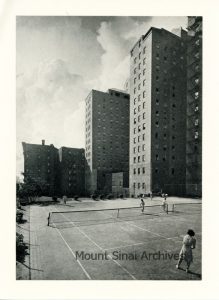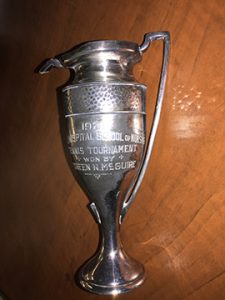This started out as a story about Althea Gibson, the first African American to win at Wimbledon, which she did on July 6, 1957. It was also about a summer sport, and being outside – two things people today find important and hopeful. But, as often happens in the Archives, those stories reminded us of other stories, which are, of course, about Mount Sinai.
In 1950, Harlem-born Althea Gibson made her U.S. Open debut at a time when tennis was largely segregated. On July 6, 1957, when she claimed the women’s singles tennis title, she became the first African American to win a championship at London’s All England Lawn Tennis and Croquet Club, aka Wimbledon. (Arthur Ashe was the first African American to win the men’s singles crown at Wimbledon in 1975. Ashe later had quadruple bypass surgery at St. Luke’s Hospital in 1979.) The Associated Press named Althea Gibson Female Athlete of the Year in 1957 and 1958. During the 1950’s, Gibson won 56 singles and doubles titles, including 11 major titles. Gibson retired from tennis and later became a professional golfer. She was voted into the National Lawn Tennis Association Hall of Fame in 1971 and died in 2003.

The Mount Sinai Hospital tennis courts on 5th Ave and 99th St, behind 5 E. 98th St., where KP is today.
Tennis has a long, up-and-down history at Mount Sinai. The first tennis court was built at the Hospital in the late 1800’s, back when the Hospital was still located at Lexington Avenue and 67th St. Space was tight, so the court was built between buildings, and the only way to get to it was to climb through a window on one of the wards. (Fortunately, a gong would sound whenever an Attending arrived at the Hospital, so the players were warned to get back inside.) In 1904, Mount Sinai moved uptown to 100th St., and it took 20 years before tennis returned. The growing House Staff asked the Trustees to build tennis courts that they could use for exercise. The Trustees

A small pewter trophy belonging to Noreen McGuire, School of Nursing Class of 1932. The trophy was for winning the tennis tournament in 1929.
eventually agreed in June 1923 and two courts were built on the southeast corner of 99th St and 5th Ave. Mount Sinai had purchased the land for future expansion needs, but had recently completed major additions to the campus and had no immediate plans to build. The courts were used by the Mount Sinai Hospital School of Nursing for gym classes, and nurses and doctors could sign up to play when a court was free.
The Aufses Archives has a wonderful interview with Gus Burton from 1988. Mr. Burton joined Mount Sinai’s staff in 1948, first as an x-ray file clerk, and then later trained as a technician in the Dept. of Radiology. What initially attracted him to work at Mount Sinai was because there was a tennis court. Here is how he described it:
Burton: …Back in those days the buses that ran along Fifth Avenue were owned by a company called the Fifth Avenue Bus Company. They had double deckers. The top deck was so that you could ride the bus for a nickel. At the time I was a student at NYU and sometimes I would take the bus down because the classes were at Washington Square. It was almost like a bus tour going down Fifth Avenue, seeing all the different places, and I saw the Hospital. I wasn’t impressed with the hospital so much, but where Klingenstein is there used to be tennis courts. At that time I was an avid tennis player, and I could see these people playing tennis. I thought it was very, very interesting, because I had found that there weren’t many places to play tennis in New York and here these people were running around playing tennis. Eventually, one day I was coming back home and I got off the bus. It was approaching the end of the semester and I said I need to find some kind of work for the summer. It was raining pretty hard, so I ran under the canopy that they had by the [Guggenheim] Pavilion. So I said, let me just check in here and see what’s going on. In those days, they didn’t really have what you call a personnel office. I guess they called it an employment office. They had about one or two clerks and the person who ran it, a Mr. Kerr (?). I just walked in and asked them if they had any jobs available. Said Mr. Kerr, “we may have some available in the radiology department. We’ll refer you to the person there who is looking for somebody and see what happens.”
So I went over and I was interviewed by a Dr. Joan Lipsay. She was the second in command in the radiology department. She was just really impressed that I came along and, sure, we’ll take you and they hired me as an X-ray file clerk. So I have always said in the years since then, that I had enough sense to come in out of the rain.
Interviewer: Did you ever get to play tennis?
Burton: Well, I found out after I started working here that those tennis courts were for the professional staff, the doctors and the nurses, and they were the ones I had seen playing on them. It so happened that one of the radiologists on our staff was an avid tennis player, he used to play out there frequently so I was able to get with him and I did get a chance to play on those tennis courts.
Unfortunately for Mr. Burton, the tennis courts were closed later in 1948, when Mount Sinai began the process of building the Klingenstein Pavilion along 5th Ave. It would be 65 years before tennis came back to Mount Sinai, but this time it was in a much different form. In 2013, it was announced that The Mount Sinai Medical Center was now the official medical services provider for the United States Tennis Association (USTA) and the U.S. Open. In addition, Alexis C. Colvin, MD, from the Leni and Peter W. May Department of Orthopaedic Surgery, would serve as the USTA’s Chief Medical Officer. In 2020, this continues to be the case. Every now and then, a mini-tennis court is built in the Guggenheim Pavilion lobby to showcase the Hospital’s role with the USTA, and for a brief moment, tennis is played again at Mount Sinai.
